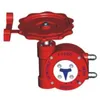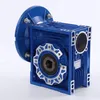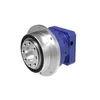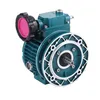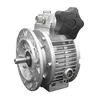A worm gearbox, also known as a worm gear reducer, is a type of gear system that consists of a worm (which resembles a screw) and a worm wheel (which resembles a typical gear). This setup allows for high torque output with compact design, making it ideal for applications requiring significant speed reduction and high shock load resistance. The unique feature of a worm gearbox is its ability to provide a large reduction ratio in a single stage, often ranging from 5:1 to 100:1, which is not easily achievable with other gear types. Additionally, the worm can easily turn the gear, but the gear cannot turn the worm due to the self-locking characteristic, adding a safety feature in many industrial setups. These gearboxes are widely used in conveyors, elevators, mining equipment, and packaging machinery due to their durability and efficiency in harsh environments.
Understanding the technical specifications of worm gearboxes is crucial for selecting the right product for your needs. Below are the essential parameters detailed in lists and tables for clarity.
| Model | Ratio | Input Power (kW) | Output Torque (Nm) | Efficiency (%) | Weight (kg) |
|---|---|---|---|---|---|
| WG-40 | 10:1 | 0.12 - 1.5 | 50 - 200 | 60 - 70 | 5.2 |
| WG-60 | 20:1 | 0.25 - 4.0 | 150 - 600 | 65 - 75 | 12.8 |
| WG-80 | 30:1 | 0.55 - 7.5 | 300 - 1200 | 70 - 80 | 25.4 |
| WG-100 | 40:1 | 1.1 - 15 | 600 - 2500 | 75 - 85 | 48.6 |
| WG-120 | 50:1 | 2.2 - 30 | 1200 - 4000 | 80 - 90 | 85.3 |
| WG-150 | 100:1 | 4.0 - 55 | 2500 - 5000 | 85 - 90 | 152.7 |
Worm gearboxes are versatile and find use in numerous industries due to their high torque and compact design. Common applications include conveyor systems in manufacturing and logistics, where they provide reliable speed control and handling of heavy loads. In the elevator industry, worm gearboxes are preferred for their smooth operation and safety features, such as the self-locking mechanism that prevents backdriving. Mining equipment often utilizes these gearboxes for their ability to withstand harsh conditions and provide consistent performance under high stress. Packaging machinery benefits from the precise speed reduction and durability, ensuring efficient production lines. Other uses include agricultural machinery, construction equipment, and robotics, where space constraints and high torque are critical factors.
Worm gearboxes offer several benefits that make them a popular choice in various sectors. One of the primary advantages is the high reduction ratio achievable in a single stage, which simplifies design and reduces the need for multiple gear sets. The self-locking feature enhances safety by preventing reverse movement, which is essential in applications like elevators or hoists. They operate quietly with low vibration, contributing to a better working environment and longer equipment life. Their compact and simple design allows for easy integration into tight spaces, making them ideal for modern machinery. Additionally, worm gearboxes are known for their durability and low maintenance requirements, especially when properly lubricated, leading to reduced downtime and cost savings over time.
Here are some frequently asked questions about worm gearboxes, answered in detail to help you understand their functionality and selection.
What is the typical efficiency range of a worm gearbox?
The efficiency of a worm gearbox generally ranges from 50% to 90%, depending on factors such as the reduction ratio, material quality, lubrication, and operating conditions. Higher reduction ratios tend to have lower efficiency due to increased friction, but advancements in materials and design have improved this over time. Proper maintenance, including regular lubrication, can help maintain optimal efficiency.
How does the self-locking mechanism work in a worm gearbox?
The self-locking mechanism occurs because of the angle of the worm thread, which creates high friction that prevents the worm wheel from turning the worm backwards. This is due to the lead angle being less than the coefficient of friction, making it irreversible under most conditions. It adds a safety feature, ensuring that loads do not reverse direction unintentionally, which is crucial in applications like lifts or conveyors.
What materials are commonly used in worm and worm wheel construction?
Worms are typically made from hardened steel, such as case-hardened or through-hardened grades, to resist wear and provide strength. Worm wheels are often constructed from bronze, brass, or cast iron because these materials offer good wear resistance and compatibility with steel worms, reducing friction and extending lifespan. The choice of material depends on the application's load, speed, and environmental factors.
Can worm gearboxes be used in high-temperature environments?
Yes, worm gearboxes can be designed for high-temperature environments up to 100°C or higher with special adaptations. This may include using high-temperature lubricants, heat-resistant materials for seals and components, and improved cooling systems. It's important to select a model rated for the specific temperature range and consult with manufacturers for custom solutions if needed.
How do I select the right worm gearbox for my application?
Selecting the right worm gearbox involves considering parameters such as required reduction ratio, input power, output torque, mounting position, operating environment, and efficiency. Start by calculating the load and speed requirements, then match them with the gearbox specifications from the table above. Also, factor in space constraints, noise levels, and maintenance needs. Consulting with technical experts or referring to manufacturer guidelines can ensure optimal performance and longevity.
What maintenance is required for a worm gearbox?
Regular maintenance for a worm gearbox includes checking and replenishing lubrication (oil or grease) as per the manufacturer's recommendations, typically every 1,000 to 2,000 operating hours or annually. Inspect for wear, leaks, or unusual noise, and replace seals or components if necessary. Keeping the gearbox clean from debris and ensuring proper alignment with connected equipment can prevent premature failure and extend service life.
Are worm gearbacks reversible?
In most cases, worm gearboxes are not reversible due to the self-locking design, meaning the worm can drive the wheel, but the wheel cannot drive the worm. However, some high-efficiency models with specific lead angles may allow reversibility under certain conditions. It's essential to check the product specifications or consult with the supplier if reversibility is a requirement for your application.
What are the noise levels like in worm gearboxes?
Worm gearboxes are known for relatively low noise levels, typically below 65 dB, due to the smooth, sliding contact between the worm and wheel. This makes them suitable for applications where noise reduction is important, such as in indoor machinery or quiet operational environments. Noise can vary based on speed, load, and maintenance, so proper installation and lubrication help minimize sound levels.
